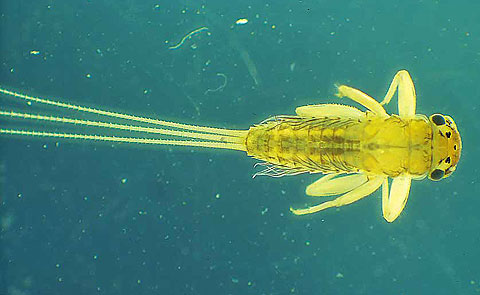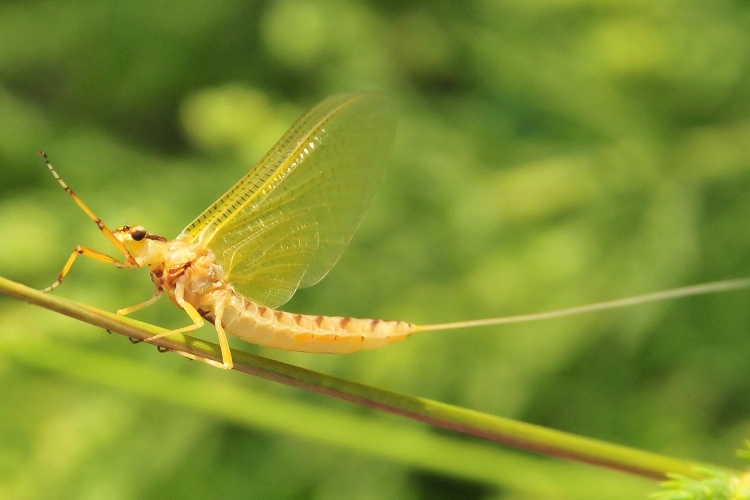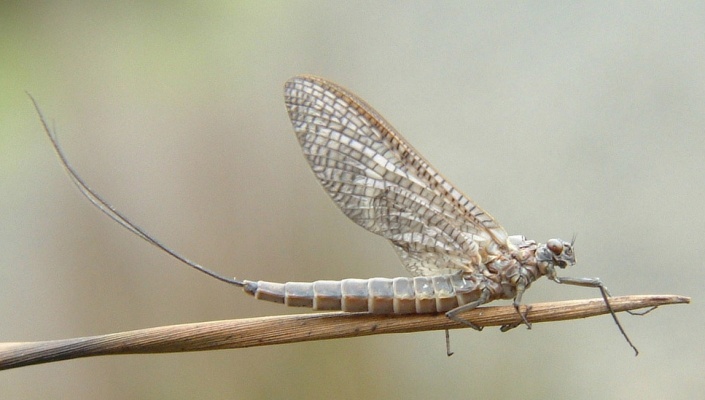
Adaptation
Certain mayfly species have developed adaptations that allow
them to take advantage  of certain
environmental niches, especially during the nymph life
cycle
stage. In particular, psammophilous mayflies
show
nymph adaptations
for partial or complete burial in the sand (Orwin,
2009). Burrowing species whose nymphs can sometimes exist
in sand tend to inhabit environments with more compact
substrata. A key adaptation that facilitates this
preference is very long claws, which are not observed in other
species. These claws allow the nymphs to anchor themselves
to grains, sand, or even layers of silt (Orwin, 2009).
They do not always remain in the sand however, another
adaptation of the psammophilous species is a
streamlined body shape that gives them increased efficiency as
swimmers (Orwin, 2009). Other species of nymph cover their bodies
with sand and have little to no claw
of certain
environmental niches, especially during the nymph life
cycle
stage. In particular, psammophilous mayflies
show
nymph adaptations
for partial or complete burial in the sand (Orwin,
2009). Burrowing species whose nymphs can sometimes exist
in sand tend to inhabit environments with more compact
substrata. A key adaptation that facilitates this
preference is very long claws, which are not observed in other
species. These claws allow the nymphs to anchor themselves
to grains, sand, or even layers of silt (Orwin, 2009).
They do not always remain in the sand however, another
adaptation of the psammophilous species is a
streamlined body shape that gives them increased efficiency as
swimmers (Orwin, 2009). Other species of nymph cover their bodies
with sand and have little to no claw s. Due to water
currents that resist the sedimentation of suspended matter, the
species that remain partially covered with sand have developed
rows of bristles located on the forelegs and mouth parts to help
them remain covered. Another adaptation is
observed in
Oligoneurisca borysthenica, which have developed tufts of
additional gills near the base of their forelimbs and mouth
parts for more efficient oxygen exchange while the abdomen is
covered by sand (Orwin, 2009).
s. Due to water
currents that resist the sedimentation of suspended matter, the
species that remain partially covered with sand have developed
rows of bristles located on the forelegs and mouth parts to help
them remain covered. Another adaptation is
observed in
Oligoneurisca borysthenica, which have developed tufts of
additional gills near the base of their forelimbs and mouth
parts for more efficient oxygen exchange while the abdomen is
covered by sand (Orwin, 2009).
An adaptation that is shared by all nymphs that inhabit sandy
river bottoms is brightly colored bodies. Most often the
nymphs bodies are light brown with faint marks of darker
pigmentation around the abdomen. These darker marks help
the nym phs
blend in with their surroundings by imitating darker grains of
sand. The rest of the body blends in well with the lighter
colored grains of sand, which makes the nymphs visible only when
they move. A unique adaptation pertaining to blending in is observed with the Cercobrachys minutes
nymphs. These are among the smallest of the mayflies and
have developed more intensely pigmented regions due to the fact
that they often attach to darker lumps of substratum (Orwin,
2009).
phs
blend in with their surroundings by imitating darker grains of
sand. The rest of the body blends in well with the lighter
colored grains of sand, which makes the nymphs visible only when
they move. A unique adaptation pertaining to blending in is observed with the Cercobrachys minutes
nymphs. These are among the smallest of the mayflies and
have developed more intensely pigmented regions due to the fact
that they often attach to darker lumps of substratum (Orwin,
2009).
Think these adaptations are interesting? Visit the
interesting
facts section to learn about an amazing mayfly phenomenon!
Back to homepage